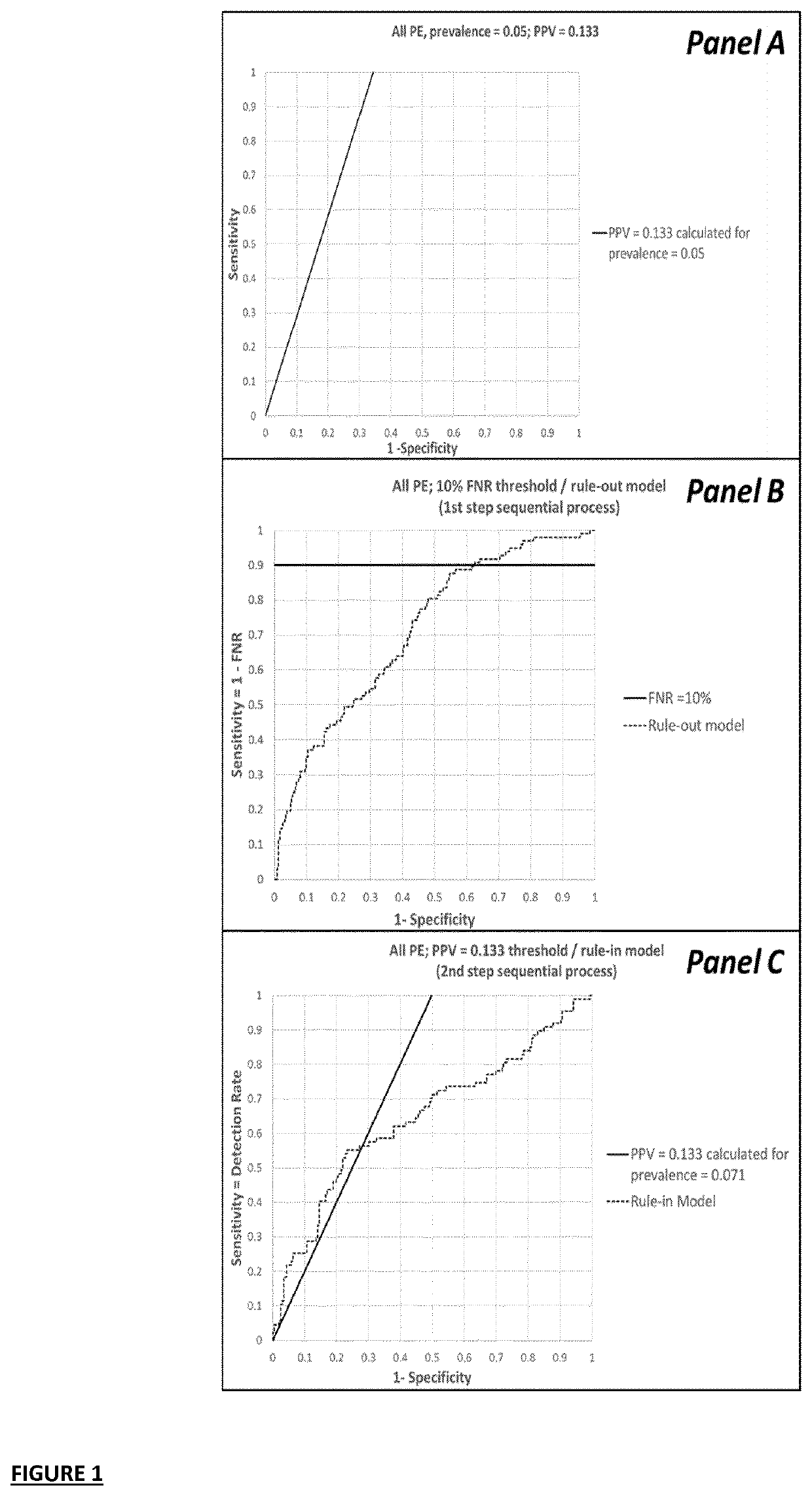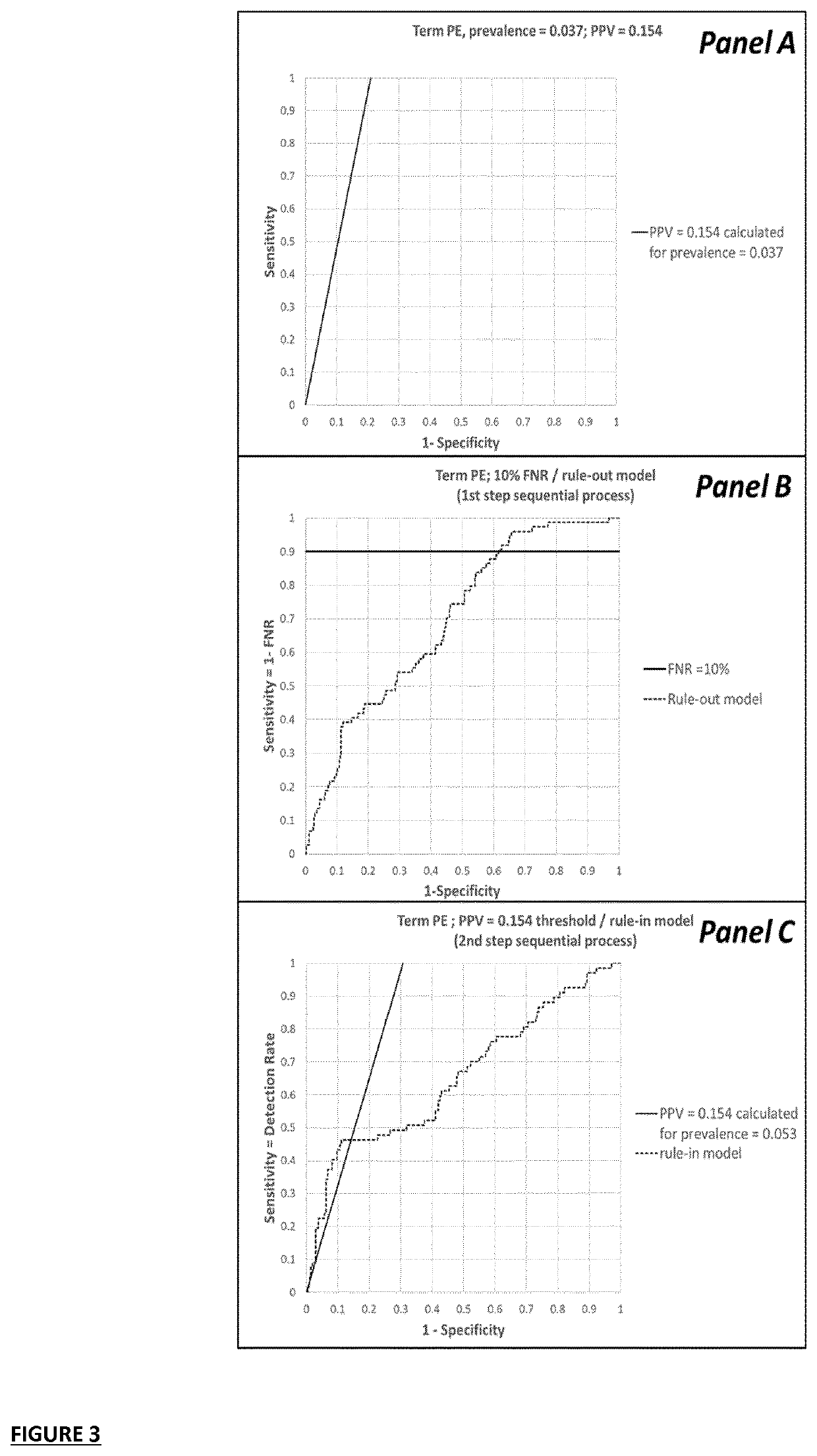Methods of predicting pre term birth from preeclampsia using metabolic and protein biomarkers
a preeclampsia and metabolic biomarker technology, applied in the field of preeclampsia prediction, can solve the problems of increasing neonatal morbidity and mortality, so as to reduce risk and improve accuracy.
- Summary
- Abstract
- Description
- Claims
- Application Information
AI Technical Summary
Benefits of technology
Problems solved by technology
Method used
Image
Examples
example 1
Participants and Specimens:
[0282]Prospective clinical samples were collected from pregnant women with a singleton pregnancy at 15+ / −1 and 20+ / −1 weeks' gestation and which were either diagnosed with preeclampsia (cases) or not diagnosed with preeclampsia (controls) in the further course of their pregnancy. All samples were obtained from participants in the SCOPE (Screening fOr Pregnancy Endpoints) prospective screening study of nulliparous women [23,24].
[0283]Written consent was obtained from each participant. The inclusion criteria applied for the study were nulliparity, singleton pregnancy, gestation age between 14 weeks 0 days and 16 weeks 6 days gestation and informed consent to participate. The exclusion criteria applied were: Unsure of last menstrual period (LMP) and unwilling to have ultrasound scan at =3 miscarriages, >=3 terminations, major fetal anomaly / abnormal karyotype, essential hypertension treated pre-pregnancy, moderate-severe hypertension at booking >=160 / 100 mmHg,...
example 2
Collection of the Analytical Methods and Statistical Models Applied
A) the Analytical Methods are Based on the Following
[0310]1. The use of an extraction solvent / protein precipitation solvent that enables the extraction of the different types (classes) of metabolites. This extraction solvent composition, being a mixture of Methanol, Isopropanol and 200 mM Ammonium Acetate (aqueous) in a 10:9:1 ratio, which in turn is fortified with 0.05% 3,5-Di-tert-4-butyl-hydroxytoluene; in the remainder of this example this solvent is referred to as the “crash”.
2. The use of a dual (High Pressure) Liquid Chromatography (LC) system to enable the identification and quantification of the different classes of metabolites in a short analytical run. The chromatographic systems were developed so that these could be directly hyphenated to a mass spectrometric detection system. This dual chromatography system allows the separation of different metabolite types / classes and at the same time generate a detect...
example 3
le Performance
[0481]For the pre-eclamspsia example elaborated in this application, non-limiting tables with univariable performance metrics of all variables considered are presented here. It will be clear from the below tables that depending on the pre-eclampsia type targeted different variables have prognostic relevance. This observation supports the approach as put forward by the inventors in this application.
Single Marker Prognostic Performance for Pre-Eclampsia Based on AUC
[0482]For each of the pre-eclampsia types considered herein, i.e. “all pre-eclampsia” (all PE), “preterm PE” and “term PE”, tables summarizing AUC (95% C1) and fold changes (FC; 95% C1) are presented. Only the variables that had a lower limit of the 95% confidence interval of AUROC greater or equal to 0.50 were selected as predictive (single) markers each of the pre-eclampsia outcomes studied.
All PE:
[0483]
TABLE 6All PE: AUG - based univariable prognostic performance assessment.FC: fold change, ICI and uCI: low...
PUM
 Login to View More
Login to View More Abstract
Description
Claims
Application Information
 Login to View More
Login to View More - R&D
- Intellectual Property
- Life Sciences
- Materials
- Tech Scout
- Unparalleled Data Quality
- Higher Quality Content
- 60% Fewer Hallucinations
Browse by: Latest US Patents, China's latest patents, Technical Efficacy Thesaurus, Application Domain, Technology Topic, Popular Technical Reports.
© 2025 PatSnap. All rights reserved.Legal|Privacy policy|Modern Slavery Act Transparency Statement|Sitemap|About US| Contact US: help@patsnap.com



